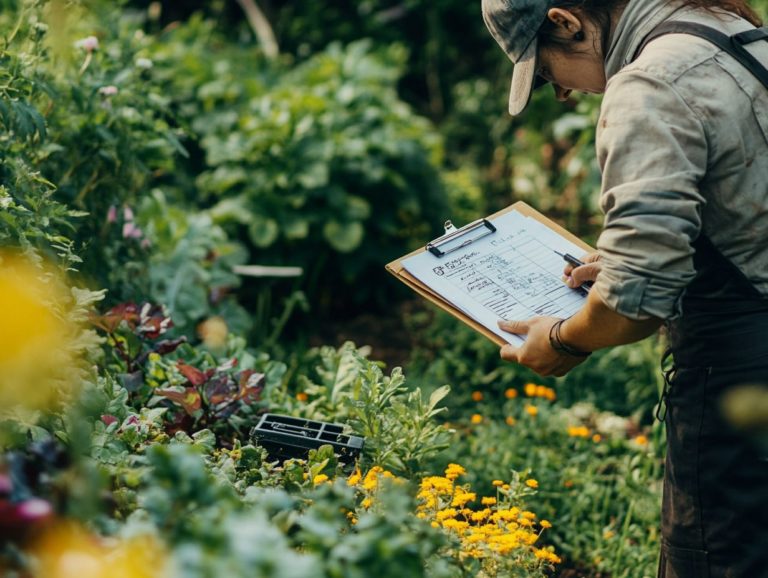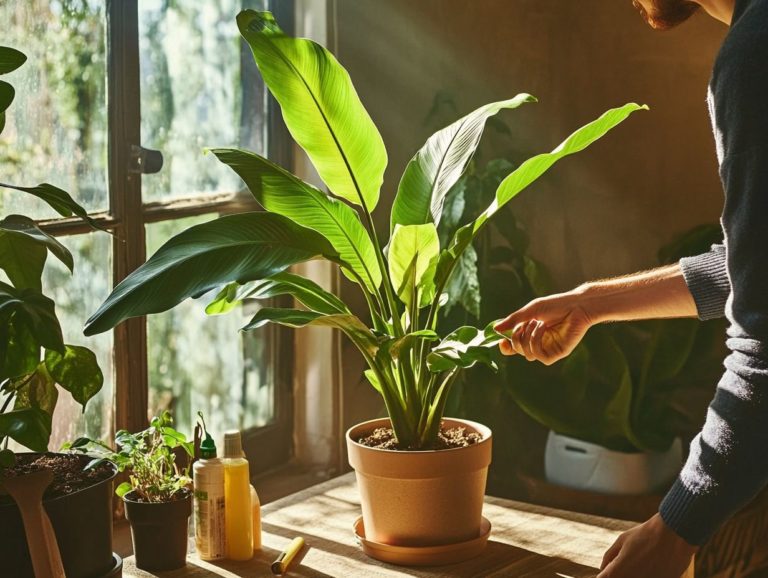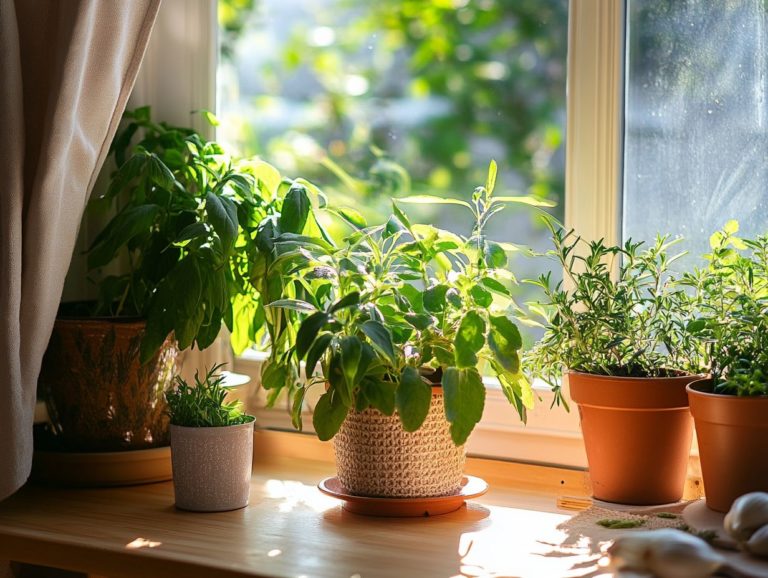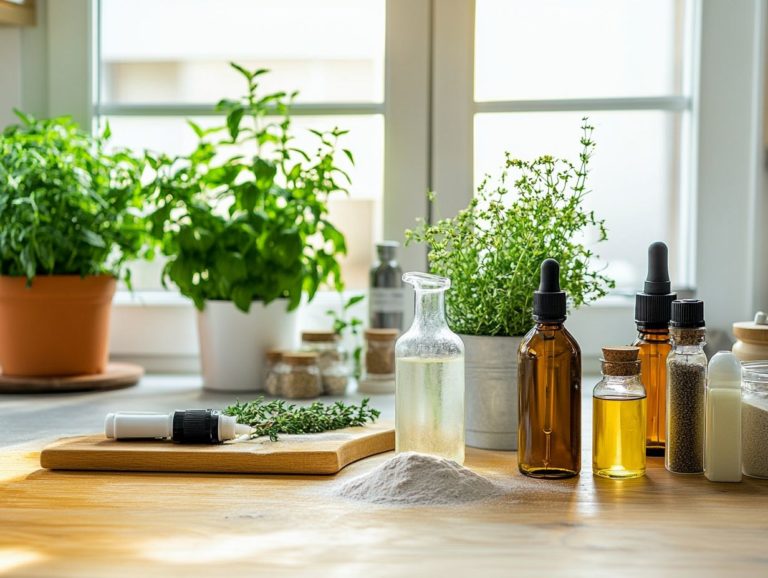Identifying and Managing Leaf Spot Diseases
Leaf spot diseases present a common challenge for gardeners and plant enthusiasts like yourself.
These conditions can affect a variety of plants, resulting in unsightly spots that may indicate deeper health issues. You will explore the signs and symptoms of leaf spot diseases, identify the various types, and delve into their causes.
Additionally, you will discover effective prevention and treatment strategies tailored to different plants, ensuring your greenery remains vibrant and beautiful.
Dive in to learn how to safeguard your plants from these disruptive ailments!
Contents
- Key Takeaways:
- Common Signs and Symptoms
- Types of Leaf Spot Diseases
- Causes of Leaf Spot Diseases
- Preventing Leaf Spot Diseases
- Treating Leaf Spot Diseases
- Managing Leaf Spot Diseases in Different Plants
- Frequently Asked Questions
- What are leaf spot diseases and how can I identify them?
- What are the common symptoms of leaf spot diseases?
- How do leaf spot diseases spread and what factors contribute to their development?
- Can leaf spot diseases be prevented?
- How can I manage leaf spot diseases if my plants are already infected?
- Are leaf spot diseases harmful to my plants?
Key Takeaways:
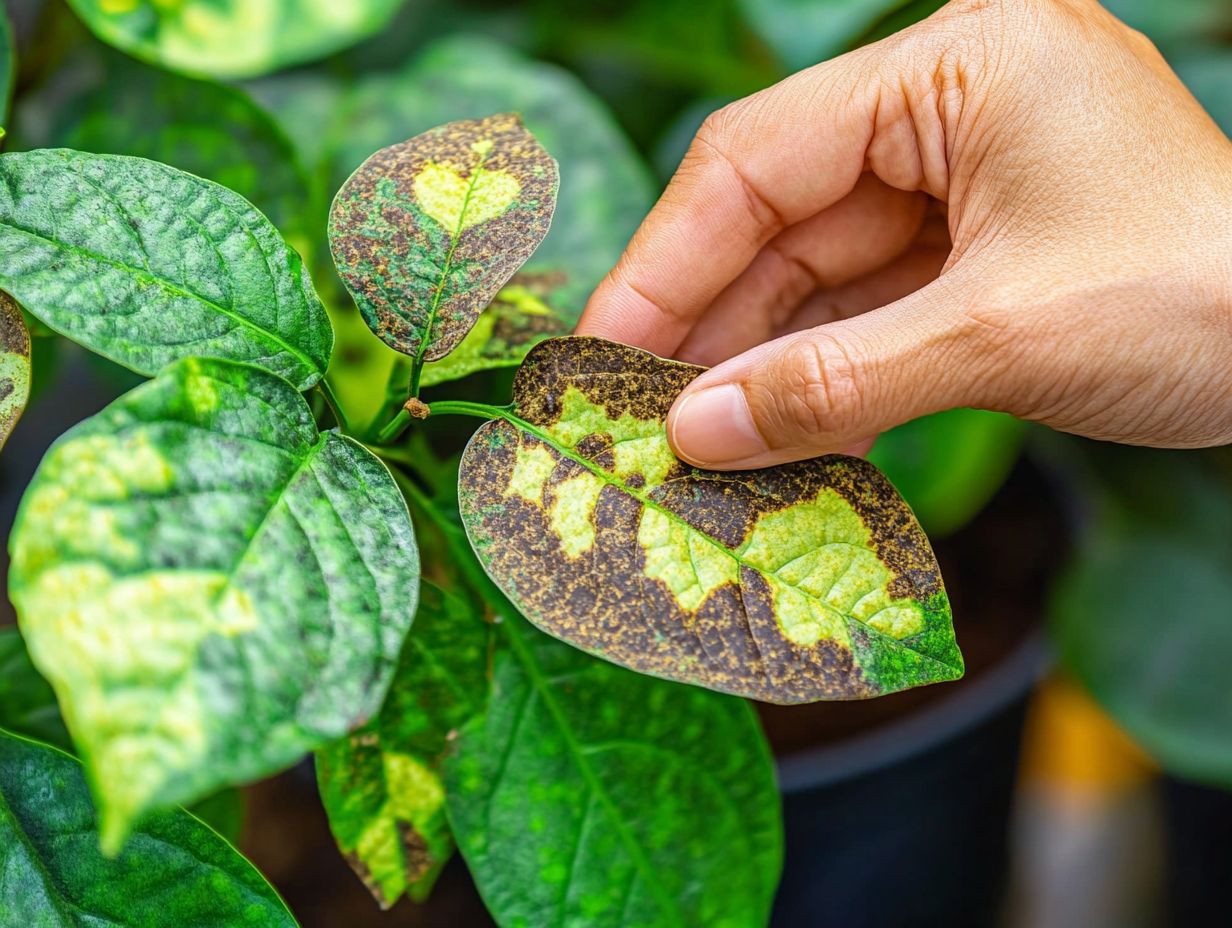
- Regularly inspect plants for visual indicators of leaf spot diseases to catch them early and prevent spread.
- Understand the different types of leaf spot diseases and their causes to effectively prevent and manage them.
- Implement effective management techniques and treatment options to prevent and treat leaf spot diseases in plants.
What are Leaf Spot Diseases?
Leaf spot diseases are a category of plant ailments characterized by unsightly discoloration and spots on leaves. They are primarily caused by a variety of fungi and bacteria. These issues can affect a wide range of plant species, from majestic trees to delicate shrubs.
Leaf spot diseases often flourish in humid environments where moisture is plentiful. To tackle these diseases effectively, it s essential to identify the specific harmful organisms at play, which can vary significantly depending on the plant species and environmental factors involved.
For example, fungi like Alternaria can create dark, dead spots on the leaves of various vegetables. Meanwhile, Septoria tends to target crops such as tomatoes, resulting in small, water-soaked spots that may lead to premature leaf drop.
The rapid spread of these pathogens is often worsened by environmental conditions like prolonged leaf wetness, temperature swings, and poor air circulation.
Bacterial leaf spot diseases can appear as greasy, water-soaked spots and may infiltrate your ornamental plants, complicating matters in lush gardens. Recognizing symptoms early and understanding the effects of weather and moisture are vital steps in mitigating these diseases and ensuring your plants remain healthy.
Common Signs and Symptoms
Keep an eye out for common signs and symptoms of leaf spot diseases manifesting in your plants:
- Dark spots on leaves
- Yellowing leaves
- Premature leaf drop
The appearance and severity of these symptoms can differ based on the specific harmful organism at play, ultimately influencing the overall health and growth of your plants.
Visual Indicators of Leaf Spot Diseases
Visual indicators of leaf spot diseases present a range of symptoms that are essential for identifying infected plants. Look out for dark brown or black spots surrounded by yellow halos on the foliage these clues can be pivotal in diagnosing the specific type of leaf spot disease affecting your plants, enabling timely intervention.
You might also notice water-soaked spots or irregularly shaped patches that change color over time, offering additional insights into the underlying pathogen. For example, if you spot oily spots, it could indicate a bacterial infection caused by Pseudomonas, which can be particularly devastating.
Recognizing these visual cues early helps you pinpoint the issue accurately and plays a crucial role in implementing effective management strategies, ultimately minimizing crop loss and promoting the overall health of your plants.
Types of Leaf Spot Diseases
You ll encounter various types of leaf spot diseases that can impact a diverse array of plant species, from shrubs and trees to ornamental plants.
Each disease stems from distinct harmful organisms and can present varying degrees of severity. This variability underscores the importance of identifying susceptible species and grasping the unique characteristics of each disease, enabling you to implement effective control and prevention strategies.
Start protecting your plants today to keep them healthy and thriving!
Identifying Different Types
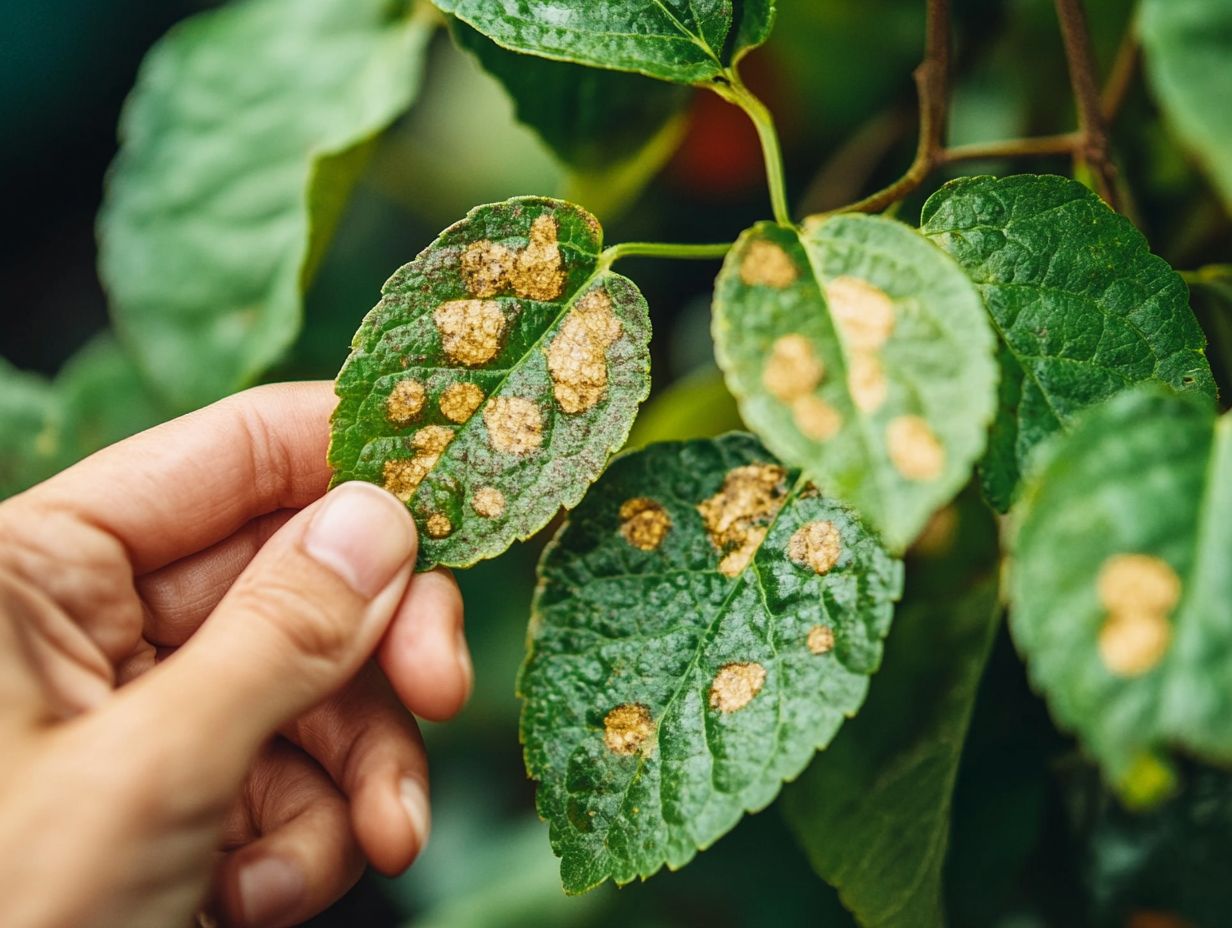
Identifying different types of leaf spot diseases requires keen observation of specific characteristics of the spots. Look for their color, shape, and size, along with the affected plant species.
Each pathogen, whether it s a fungus or bacteria, has distinct traits that can guide you toward an accurate diagnosis. For example, Cercospora leaf spots typically present as circular or oval lesions with a striking dark edge surrounding a lighter center.
These spots often target plants like beets and carrots. On the other hand, bacterial leaf spots may appear as water-soaked tissues that turn brown and take on irregular shapes, commonly found on peppers and tomatoes.
Recognizing these differences is essential, as it enables targeted treatments and effective management practices. This proactive approach helps prevent further damage and ensures the overall health of your plants.
Causes of Leaf Spot Diseases
The causes of leaf spot diseases are complex, stemming from a combination of environmental factors and biological pathogens such as fungi and bacteria.
High moisture levels, insufficient air circulation, and poor gardening hygiene create optimal conditions for these infections to thrive. Understanding these factors is key to protecting your plants!
Environmental and Biological Factors
Environmental and biological factors significantly influence the occurrence and severity of leaf spot diseases. Moisture levels act as a primary catalyst for infection by various pathogens.
High humidity creates an ideal environment for fungal spores to flourish, making leaves more vulnerable to pathogens. Temperature is another key player; warmer climates can speed up the life cycles of these pathogens, resulting in faster disease progression.
Specific pathogens interact uniquely with different plant types, as host susceptibility often depends on genetic factors and the overall health of the plant. Some species might show resilience against particular leaf spots, while others can be significantly impacted.
This interplay highlights the need to monitor environmental conditions while deepening your understanding of plant biology.
Preventing Leaf Spot Diseases
To prevent leaf spot diseases, employ a mix of effective management strategies and good gardening habits that enhance plant health and minimize vulnerability to infection.
Both organic and chemical control methods can be tailored to the severity of the outbreak and the unique needs of your plants.
Effective Management Techniques
Effective management techniques for leaf spot diseases include various gardening practices designed to improve plant health and reduce infection symptoms. Regular maintenance routines can enhance air circulation and decrease moisture on leaves.
Adopt proper watering practices, such as watering at the base of the plants instead of from above, to significantly reduce moisture-related issues affecting the leaves. It’s also crucial to inspect your plants regularly and swiftly remove any infected foliage to prevent disease spread.
Enhancing garden hygiene by clearing away fallen leaves and debris minimizes the chances of disease-laden spores thriving and fosters a healthier overall growing environment. By embracing these techniques, you can control leaf spots in indoor plants and promote vigorous plant development.
Treating Leaf Spot Diseases
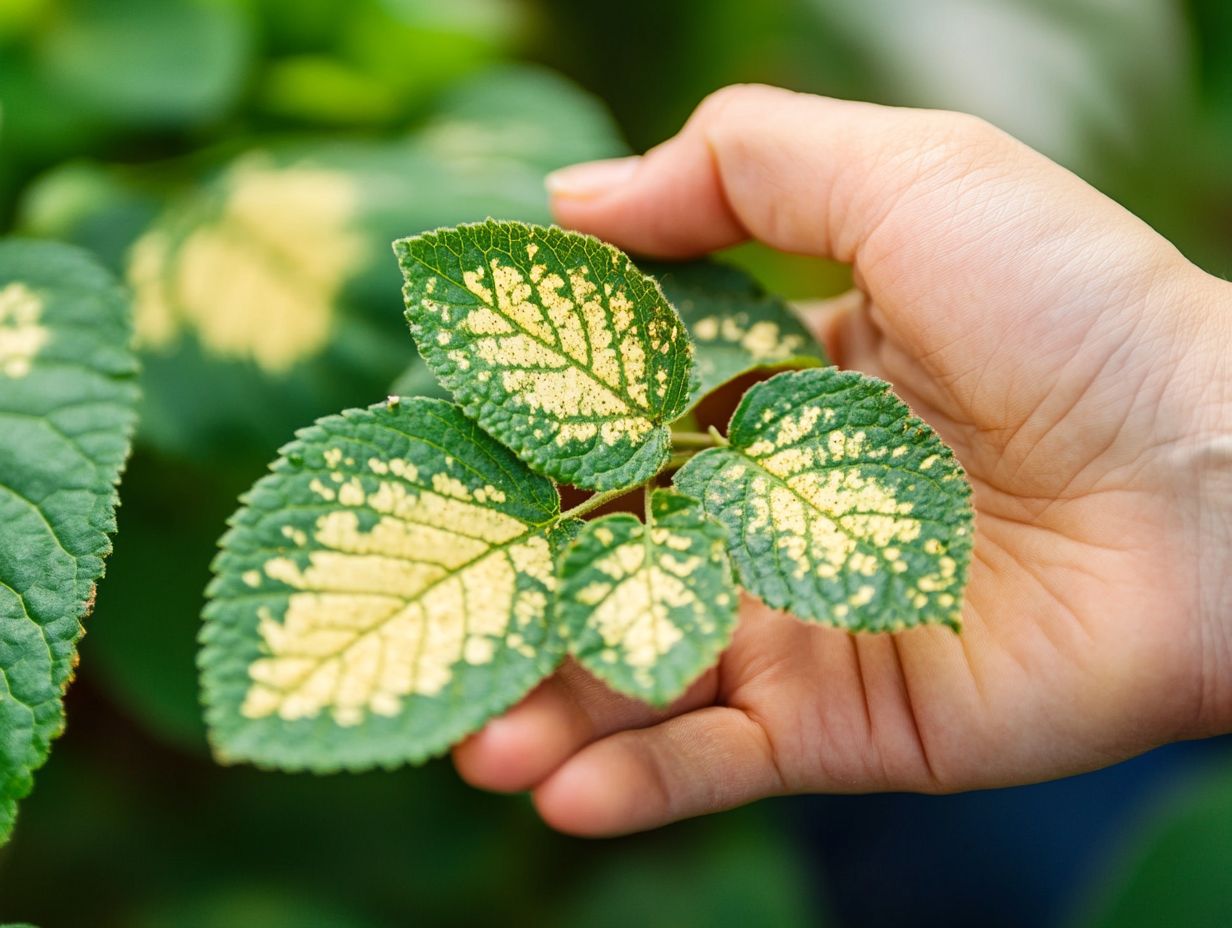
To effectively tackle leaf spot diseases, you need a comprehensive understanding of the various treatment options available from organic fungicides to chemical control measures.
Your choice of treatment will often depend on the specific pathogen identified and the severity of the disease affecting your plants. Act now to protect your plants and ensure a thriving garden!
Available Treatment Options
Available treatment options for leaf spot diseases include organic plant sprays that fight fungus and chemical controls. Each option targets specific pathogens while promoting the overall health of your plants. Understanding these options is essential for you as a gardener aiming to effectively manage and eradicate leaf spot diseases.
Organic fungicides, such as neem oil and copper-based solutions, create an unfriendly environment for fungi. They disrupt their life cycles and prevent spore germination. Chemical controls like chlorothalonil or propiconazole deliver a swift knockdown of established infections.
You can choose between these treatments based on the severity of the disease and specific pathogens involved. By integrating these solutions with sound cultural practices, such as proper watering and adequate spacing, you can enhance their effectiveness, leading to healthier and more resilient plants overall.
Managing Leaf Spot Diseases in Different Plants
Managing leaf spot diseases in your plants demands personalized strategies. These strategies hinge on the specific species involved and their individual susceptibility to various pathogens. By understanding each plant’s care requirements, you can greatly enhance your management efforts and achieve more favorable outcomes.
Specific Strategies for Different Types of Plants
Strategies for managing leaf spot diseases vary across different plant types. This underscores the importance of tailored care approaches. Certain species may require meticulous attention to their watering practices and environmental conditions to stave off infection.
Your management strategies could involve adjusting irrigation techniques to prevent excessive moisture that invites fungal growth. Ensuring proper air circulation around your plants is crucial, as is selecting disease-resistant varieties when possible.
For particularly susceptible species like Hosta spp., which thrive in shaded areas, closely monitoring humidity levels is essential. Consider using fungicides right away during high-risk periods to protect your plants!
In a similar vein, Kalmia latifolia could benefit from careful pruning to enhance airflow and minimize leaf wetness. This highlights the necessity of understanding each plant’s unique needs to sustain its health and resilience.
Frequently Asked Questions
What are leaf spot diseases and how can I identify them?

Leaf spot diseases are fungal or bacterial infections that affect the leaves of plants, causing dark spots to form. These spots can vary in size, shape, and color, and may have a yellow or brown border. To identify leaf spot diseases, look for distinct patterns on the leaves, such as concentric rings or angular spots.
What are the common symptoms of leaf spot diseases?
The most common symptoms include dark spots on the leaves, yellowing or browning of the affected area, and premature leaf drop (defoliation). Some leaf spot diseases may also cause lesions or blisters on the leaves.
How do leaf spot diseases spread and what factors contribute to their development?
Leaf spot diseases can spread through wind, rain, insects, and contaminated gardening tools. They are more likely to develop in warm, humid environments and on plants that are stressed by factors like poor nutrition or overcrowding.
Can leaf spot diseases be prevented?
While you cannot completely prevent leaf spot diseases, you can reduce their likelihood. Maintain good plant hygiene, avoid overhead watering, provide proper spacing between plants, and promote healthy growth through proper fertilization and irrigation.
How can I manage leaf spot diseases if my plants are already infected?
If your plants are already infected, remove and destroy any infected leaves to prevent the spread of the disease. You can also use fungicides or bactericides to control the infection, but be sure to follow the instructions carefully and use protective gear when applying these chemicals.
Check your plants regularly and consider seeking professional advice if needed to maintain their health!
Are leaf spot diseases harmful to my plants?
In most cases, leaf spot diseases are not a big problem for your plants. But if infections happen often or are severe, they can weaken the plant and make it more likely to get sick from other issues.
It’s essential to keep an eye on leaf spot diseases. Taking care of them will help ensure your plants stay healthy and vibrant!

